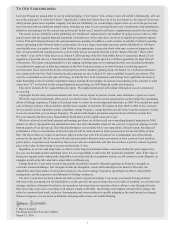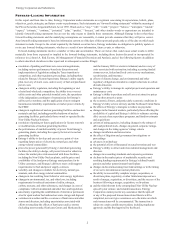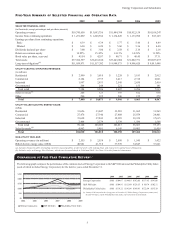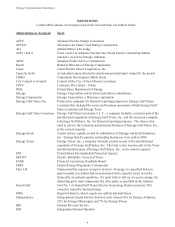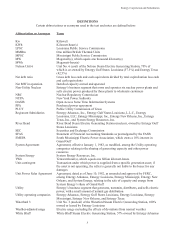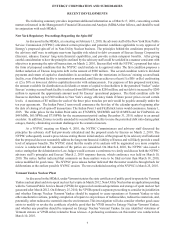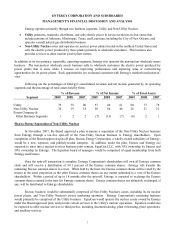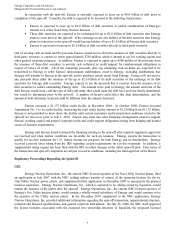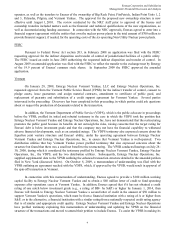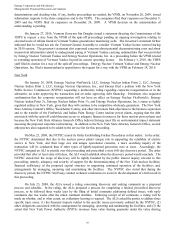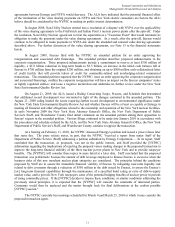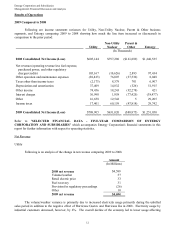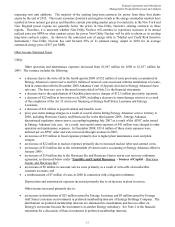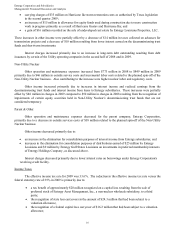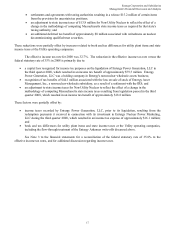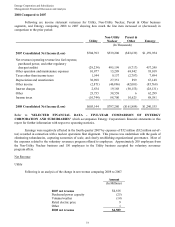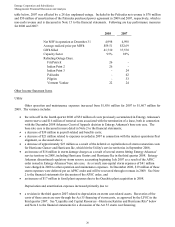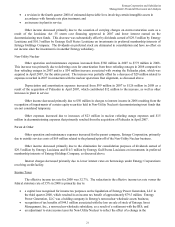Entergy 2009 Annual Report Download - page 13
Download and view the complete annual report
Please find page 13 of the 2009 Entergy annual report below. You can navigate through the pages in the report by either clicking on the pages listed below, or by using the keyword search tool below to find specific information within the annual report.Entergy Corporation and Subsidiaries
Management's Financial Discussion and Analysis
9
agreements between Entergy and NYPA would decrease. The ALJs have indicated that the potential financial effect
of the termination of the value sharing payments on NYPA and New York electric consumers are factors the ALJs
believe should be considered by the NYPSC in making its public interest determination.
In August 2008, Non-Utility Nuclear entered into a resolution of a dispute with NYPA over the applicability
of the value sharing agreements to the FitzPatrick and Indian Point 3 nuclear power plants after the spin-off. Under
the resolution, Non-Utility Nuclear agreed not to treat the separation as a "Cessation Event" that would terminate its
obligation to make the payments under the value sharing agreements. As a result, after the spin-off, Enexus would
continue to be obligated to make payments to NYPA due under the amended and restated value sharing agreements
described above. For further discussion of the value sharing agreements, see Note 15 to the financial statements
herein.
In August 2009, Enexus filed with the NYPSC an amended petition for an order approving the
reorganization and associated debt financings. The amended petition describes proposed enhancements to the
corporate reorganization. These proposed enhancements include a commitment to reserve at least $350 million of
liquidity, a $1.0 billion reduction in long-term bonds to $3.5 billion, an increase in the initial cash balance left at
Enexus to $750 million from the original $250 million, and obtaining an up to $500 million cash-collateralized letter
of credit facility that will provide letters of credit for commodity-related and non-hedging-related commercial
transactions. The amended petition requested that the NYPSC: issue an order approving the corporate reorganization
and associated financings; confirm the corporate reorganization will have no impact on the Enexus companies' status
as lightly regulated entities; and issue a negative declaration and undertake no further review under the New York
State Environmental Quality Review Act.
On August 21, 2009, the ALJs issued a Ruling Concerning Scope, Process, and Schedule that determined
that additional record development was warranted in light of the changes contained in the amended petition. The
August 21, 2009 ruling limited the issues requiring further record development to environmental significance under
the New York State Environmental Quality Review Act and whether Enexus will be at least as capable as Entergy in
meeting all financial and other obligations related to the ownership and operation of the New York nuclear facilities.
In early November 2009 the New York State Attorney General's Office, the New York Department of Public
Service's Staff, and Westchester County filed initial comments on the amended petition stating their opposition to
Enexus' request in the amended petition. Various filings continued to be made into January 2010 in accordance with
the procedures and schedule ordered by the ALJs, and the New York State Attorney General's Office, the New York
Department of Public Service's Staff, and Westchester County continue to oppose the transaction.
At a hearing on February 11, 2010, the NYPSC discussed Entergy's petition and issued a press release later
that same day. The press release states, in part, that the NYPSC "received a report from senior Staff of the
Department of Public Service (Staff) addressing a petition submitted by Entergy Corporation.... In its report, Staff
concluded that the transaction, as proposed, was not in the public interest, and Staff provided the [NYPSC]
information regarding the implications of rejecting the proposal versus making changes to the proposed transaction to
improve the long-term financial stability of the three nuclear power plants in New York and to provide ratepayer
benefits. The [NYPSC] will consider these topics in more detail at a later date. Staff concluded that the proposed
transaction was problematic because the amount of debt leverage employed to finance Enexus is excessive when the
business risks of this new merchant nuclear plant enterprise are considered. The principles behind the conditions
proposed by Staff are to assure the immediate financial viability of Enexus by mitigating near-term liquidity risk
related to debt covenants through a reduction of $550 million in the debt issued by Enexus, to assure the Enexus’ s
[sic] long-term financial capabilities through the maintenance of a specified bond rating or ratio of debt-to-equity
market value, and to provide New York ratepayers some of the potential hedging benefits of nuclear power in periods
of rising commodity prices. If the [NYPSC] decides to impose these conditions, or similar conditions addressing the
previously stated principles, it is expected that the [NYPSC] will consider the comments of interested parties.
Comments would then be analyzed and the matter brought back for final deliberations at the earliest possible
[NYPSC] session."
The NYPSC currently has meetings scheduled for March 4 and March 25, 2010 at which it may consider the
proposed transaction again.
11


